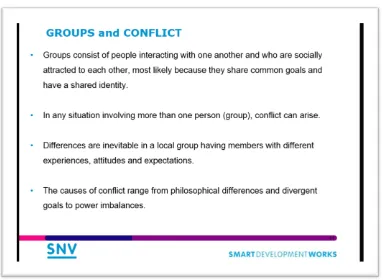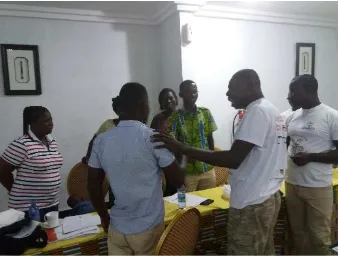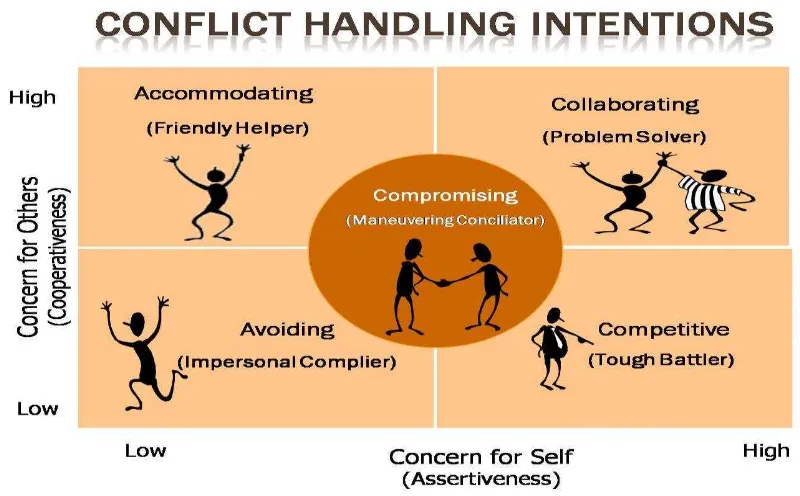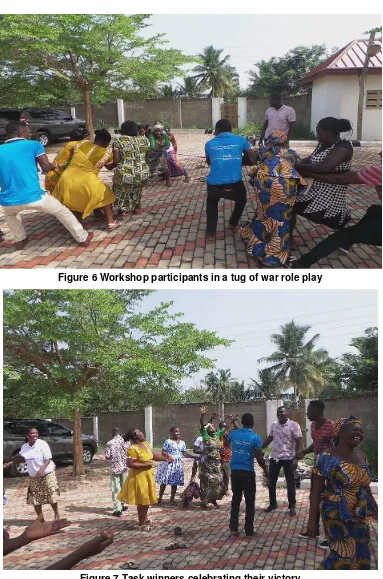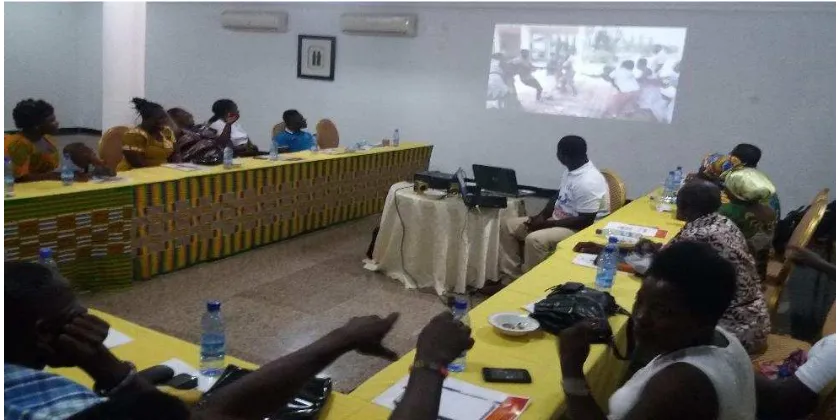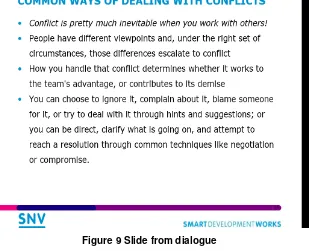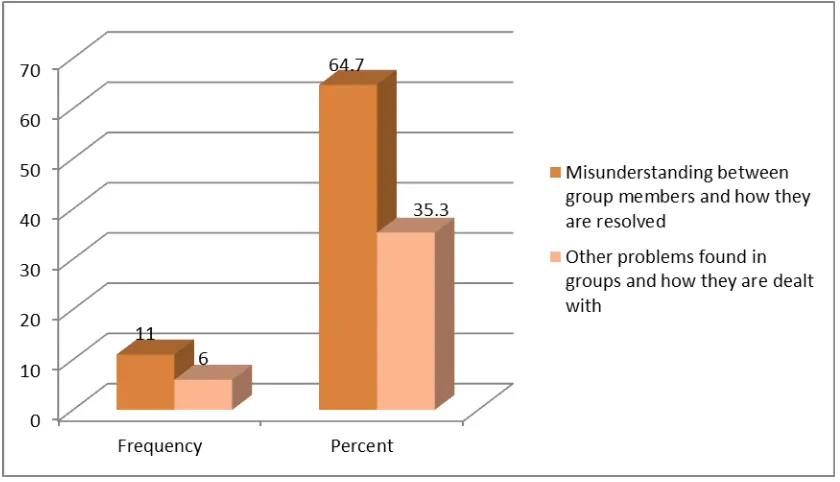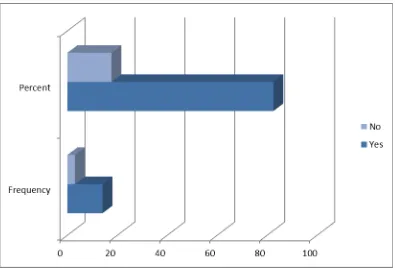SUSTAINABLE FISHERIES
MANAGEMENT PROJECT (SFMP)
Hownam Dialogue Report
Leadership and Conflict
Management
This publication is available electronically in the following locations: The Coastal Resources Center
http://www.crc.uri.edu/projects_page/ghanasfmp/
Ghanalinks.org
https://ghanalinks.org/elibrary search term: SFMP USAID Development Clearing House
https://dec.usaid.gov/dec/content/search.aspx search term: Ghana SFMP
For more information on the Ghana Sustainable Fisheries Management Project, contact:
USAID/Ghana Sustainable Fisheries Management Project Coastal Resources Center
Graduate School of Oceanography University of Rhode Island
220 South Ferry Rd.
Narragansett, RI 02882 USA
Tel: 401-874-6224 Fax: 401-874-6920 Email: info@crc.uri.edu
Citation: Adeborna, D. (2017). Hownam Dialogue Report: Leadership and Conflict
Management Training. The USAID/Ghana Sustainable Fisheries Management Project (SFMP). Narragansett, Coastal Resources Center, Graduate School of Oceanography, University of Rhode Island and SNV Netherlands Development Organisation. GH2014_GEN008_SNV 27 pp.
Authority/Disclaimer:
Prepared for USAID/Ghana under Cooperative Agreement (AID-641-A-15-00001), awarded on October 22, 2014 to the University of Rhode Island, and entitled the USAID/Ghana Sustainable Fisheries Management Project (SFMP).
This document is made possible by the support of the American People through the United States Agency for International Development (USAID). The views expressed and opinions contained in this report are those of the SFMP team and are not intended as statements of policy of either USAID or the cooperating organizations. As such, the contents of this report are the sole responsibility of the SFMP team and do not necessarily reflect the views of USAID or the United States Government.
Cover photo: A section of participants celebrating after winning a group task (Credit:
Detailed Partner Contact Information:
USAID/Ghana Sustainable Fisheries Management Project (SFMP) 10 Obodai St., Mempeasem, East Legon, Accra, Ghana
Telephone: +233 0302 542497 Fax: +233 0302 542498
Maurice Knight Chief of Party maurice@crc.uri.edu
Kofi Agbogah Senior Fisheries Advisor kagbogah@henmpoano.org Nii Odenkey Abbey Communications Officer nii.sfmp@crcuri.org
Bakari Nyari Monitoring and Evaluation Specialist hardinyari.sfmp@crcuri.org Brian Crawford Project Manager, CRC brian@crc.uri.edu
Justice Odoi USAID Administrative Officer Representative Jodoi@usaid.gov
Kofi.Agbogah #3 Third Nautical Close,
Nungua, Accra, Ghana
giftyasmah@Daasgift.org Daasgift Quality Foundation
Headmaster residence, Sekondi College Sekondi, Western Region, Ghana 233 243 326 178
For additional information on partner activities: CRC/URI: http://www.crc.uri.edu
CEWEFIA: http://cewefia.weebly.com/
DAA: http://womenthrive.org/development-action-association-daa Daasgift:
https://www.facebook.com/pages/Daasgift-Quality-Foundation-FNGO/135372649846101 Friends of the Nation: http://www.fonghana.org Hen Mpoano: http://www.henmpoano.org
SNV: http://www.snvworld.org/en/countries/ghana SSG Advisors: http://ssg-advisors.com/
ACRONYMS
CEWEFIA Central and Western Region Fish Improvement Association CLaT Child Labor and Trafficking
DAA Development Action Association
TABLE OF CONTENTS
The objective of the hownam dialogue (Year three) ... 2
LIST OF FIGURES
Figure 1 Two people appear to be involved in an argument ... 4
Figure 2 Conflict and resolutions ... 4
Figure 3 Groups and Conflict ... 5
Figure 4 Participants dispute over contributions ... 6
Figure 5 Table of conflict management methods ... 7
Figure 6 Workshop participants in a tug of war role play ... 8
Figure 7 Task winners celebrating their victory ... 8
Figure 8 Participants reflecting on the tug of war exercise ... 9
Figure 9 Slide from dialogue ... 10
Figure 10 Graph on participants’ response to question 1 ... 12
Figure 11 Chart on participants’ response to question 2... 13
Figure 12 Chart on participants’ response to question 3... 14
Figure 13 Chart on participants’ response to question 4... 15
Figure 14 Chart on participants’ response to question 5... 16
Figure 15 Chart on participants’ response to question 6... 17
Figure 16 Chart on participants’ response to question 7... 18
Figure 17 Chart on participants’ response to question 8... 19
Figure 18 Chart on participants’ response to question 9... 20
LIST OF TABLES
Table 1 Table on participants’ response to question 1 ... 11Table 2 Table on participants’ response to question 2 ... 12
Table 3 Table on participants’ response to question 3 ... 13
Table 4 Table on participants’ response to question 4 ... 14
Table 5 Table on participants’ response to question 5 ... 15
Table 6 Table on participants’ response to question 6 ... 16
Table 7 Table on participants’ response to question 7 ... 17
Table 8 Table on participants’ response to question 8 ... 18
ACKNOWLEDGEMENT
I would like to acknowledge the support of Development Action Association (DAA) for their remarkable assistance in organising participants for the dialogue and also with their support with translations during the two day dialogue/workshop. I would also like to say a big thank you to all the participants who took time away from their busy schedules to be part of this dialogue and to strengthen their skills to enable them make a difference in their communities.
EXECUTIVE SUMMARY
The hownam dialogue is part of the broader desired outcome of strengthening gender roles in fishery co-management to benefit communities and households. It is also one of the gender mainstreaming interventions under IR5 of the Sustainable Fisheries Management Project (SFMP) which seeks to strengthen the capacity of fishery associations or fish processing groups. “Hownam” is a Fante word from Ghana which means fish smoking.
The hownam dialogue started in year two of the SFMP as a unique program to help women and men groups to understand leadership and develop the important skills needed for taking up leadership roles. It was also to help understand group dynamics and encourage informal discussions at meetings on issues affecting the group and communities (including CLaT) and to solicit support from each other. It aims to provide a unique chance to participants to understand how they, as individuals operate within a group, experience unspoken attitudes, personalities, leadership, authority and conflicts among others. It is about groups and the individual. The understanding and learning from the group process is supposed to lead to the understanding of leadership, power, and authority and conflict management.
In year three, the hownam dialogue aims to highlight the importance of group dynamics and conflict management by using practical examples and group exercises.
Through group experiences (engaging with) rather than teaching, informal group discussions, presentations, video discussions, role plays and group exercises, the dialogue gives
participants the opportunity to experience group dynamics, enable participants understand how power, authority, and leadership play out in a group. It also enables participants understand group conflict management and develops participants leadership ability and conflict management skills.
SECTION ONE
Introduction
The hownam dialogue is part of the broader desired outcome of strengthening gender roles in fishery co-management to benefit communities and households. It is also one of the gender mainstreaming interventions under IR5 of the Sustainable Fisheries Management Project (SFMP) which seeks to strengthen the capacity of fishery associations or fish processing groups under Development Action Association (DAA), Central and Western Region Fish Improvement Association (CEWEFIA) and members of the National Fish Processors and Traders Association (NAFPTA).
The hownam dialogue started in year two of the SFMP as a unique training of trainers (ToT) program designed by SNV to help women and men groups to understand leadership and develop the important skills needed for taking up leadership roles. It was also to help understand group dynamics and encourage informal discussions at meetings on issues
The dialogue process is about learning from group experience (engaging with) rather than teaching. It aims to provide a unique chance to participants to understand how they, as individuals operate within a group, experience unspoken attitudes, personalities, leadership, authority and conflicts among others. It is about groups and the individual. The understanding and learning from the group process is supposed to lead to the understanding of leadership, power, and authority and conflict management.
“Hownam” is a Fante word from Ghana which means fish smoking.
In view of the success of the year two hownam program and the issues identified by the training, hownam in year three of the SFMP has been approved to continue to build the capacity of fish processing groups and also to continue to provide a unique chance for the members to experience group dynamics and to understand conflicts within groups and how to effectively manage these conflicts to ensure the survival and the progress of the group.
Therefore, a dialogue manual was developed in November 2016 and a 1st phase dialogue was carried out on the 29th and 30th November 2016 for 29 members from NAFPTA and 5 fish processing groups under CEWEFIA.
In an effort to ensure that at least ten fish processing groups benefit from the hownam dialogue on leadership and conflict management under the SFMP in year three, a 2nd phase of the dialogue was carried out in Apam on the 25th and 26th April 2017 for another five fish processing groups under DAA from the Apam and Winneba communities.
This report therefore aims to highlight the key areas of the dialogue in Apam and the relevant results achieved.
The objective of the hownam dialogue (Year three)
The dialogue aims to provide a unique chance to participants to experience group dynamics and to understand how they, as individuals operate within a group. It also aims to develop participants’ understanding and skills on leadership, authority, conflicts within groups, and common ways of dealing with conflicts within groups.
The key objective of the hownam dialogue in year three is to increase participants’
understanding of group conflict and group conflict management. In doing this, the dialogue aims to highlight the importance of group dynamics and conflict management by using practical examples and group exercises.
Learning outcomes
Enable participants experience group dynamics
Enable participants understand how power, authority, and leadership play out in a group
Enable participants understand group conflict management
Develop participants leadership ability and conflict management skills is developed Training method
Venue
The dialogue took place at Smayak Hotel in Apam, Central Region, Ghana. Participants
The dialogue was attended by a total of 20 participants of which 13 were females and 7 were males from the SFMP implementing partner Development Action Association (DAA), some members of 7 fish processing groups under DAA and some members of the National Fish Processors and Traders Association (NAFPTA).
SECTION TWO
The dialogue
The hownam dialogue on leadership and conflict management started with an introduction by the facilitator on what the dialogue is about and what the learning outcomes will be. This was to ensure participants’ readiness to be involved in group work, role plays and discussions. Also, their involvement in the group is relevant for the learning process.
In an attempt to ensure that all participants have the same understanding of the concept especially for those that are new to the dialogue, the individuals involved in the year two dialogue were asked to:
Share what they learned from year two hownam dialogue and practical field experience.
Success/achievements E.g. Experiences of group dynamics, power and authority. How the year 2 training influenced any change on their group experiences?
What they have done differently since, as a result of the training?
Whilst 4 participants were involved in the year 2 dialogue, 2 of these participants admitted that they have not had the opportunity to implement the learnings from the year two dialogue with their group members. However, they stated that the dialogue has helped them as
individuals in understanding power and authority within groups. Anthony Appiah, a representative from the Fisheries Commission who works closely with the fish processors highlighted that as a result of the hownam dialogue on group dynamics, he now respects and accept individuals’ view in a group and tries to give everyone a chance. In his words, he stated that “I now show some moderation”.
Another participant, Emelia Nortey, who manages the DAA Fisheries Training Centre also explained how the dialogue in year two helped her to understand better the dynamics of the groups the training centre works with and how she, as the manager now seeks the best solution to conflicts from within the group.
Knowledge Assessments
In view of the introductory discussions which seemed to have given participants an understanding into the subject, a pre-dialogue assessment form to evaluate the impact of the dialogue was shared by the facilitator and completed by each participant. This was to assess participants’ understanding of the concept of leadership and conflict management before the workshop/dialogue begins. A post-dialogue assessment was also completed at the end of the dialogue to help compare any changes of understanding of the concept.
Conflicts
However, before the key role plays, participants’ views were sought on the images below and if the images resonate with their experiences within their fish processing groups.
Figure 1 Two people appear to be involved in an argument
Figure 2 Conflict and resolutions
As with the previous dialogue in Elmina, these images generated a lot of discussions as it appeared to have evoked personal and group experiences, internal feelings, and emotions as expected. What was interesting at this stage, was that, the discussions about conflicts
resonated with everyone and almost every single participant engaged with the discussions on this image. Based on my experience of group work, this explains that there was a feeling of comfort and willingness to engage with the learning process. Interestingly, conflicts about money appears to always generate conversations in the dialogues. As in the case of the previous dialogues, it was again clear that ‘money’ was a key factor in most of the conflicts experienced by participants within their fish processing groups.
Figure 3 Groups and Conflict
Key Role plays/tasks
To ensure that participants have the best experience to achieve the aims of the dialogue they were engaged in two key role plays/tasks during the workshop with focus on groups’ conflict and leadership.
Task 1
Money in a pot
Participants were separated into three groups of seven members each Each group chose a leader to facilitate the task.
Participants from individual groups put an undisclosed amount of money into a pot. All the money was put together by the facilitator and was re-distributed to participants
based on what they claim to have put in the pot.
Expected outcomes:
To explain the importance of trust and honesty within a group.
To examine how the groups manage conflicts that may arise from the process Identify leaders and their roles in group conflict management
Results
This task produced exact results the dialogue expected as experienced in the previous dialogue in Elmina. Participants went quiet after the facilitator put the total amounts of money contributed together in one pot. It was obvious that participants were getting anxious about their contributions at this point.
Whilst the facilitator explored the issue of trust and the hope that every individual gets back what they contributed, one participant who physically appeared more anxious than the others, shrugged off her shoulder and said, “I do not mind if I do not get my money back. I have had some bad experiences with group contributions”. Her comments generated a lot of initial concerns and discussions about ‘trust’ and if group members will get back exactly the undisclosed amount every individual put into the pot. These concerns were revealed in the redistribution of the ‘undisclosed’ amount of money contributed by each individual. Whilst one group out of the three groups was able to share ‘honestly’ their contributions without any problems, the exercise resulted in conflicts and conflict management for
members from two out of the three the groups as two individuals did not get back what they claimed to have put in the pot. This therefore led to disputes within the group about the following:
The honesty of group members
The inadequate system of verifying and recording individual’s contributions Identification of a leader within the group to facilitate the debates/disputes If and how the group pays her back what she claims to have contributed.
Figure 4 Participants dispute over contributions
The groups identified leaders to manage the disputes
Ensure there is a common verification system of member contributions in the future Ensure there is an effective recording mechanism in the future.
With the support of a chosen leader, every member of the group was asked to contribute a percentage to make up for the difference
Group reflections and analysis
After the groups managed to reach an agreement, the facilitator led a reflection session which sought to explore the individual experiences and the roles played. Participants went through the diagram in Figure 5 below and explained what role they played in the diagram. The outcome of this is that it gave every individual the opportunity to speak about how they felt and what roles they played in the group conflict management process.
Figure 5 Table of conflict management methods
Task 2
Tug of war exercise
This three way rope exercise/task was one of the key tasks participants undertook to enable them to understand group conflict and ways to manage those conflicts.
In this task, a red mark was made in the middle of the rope. This red mark on the rope was at a perpendicular angle to the exact center point on the ground, before the commencement of the game. A white mark is made exactly 13 feet from the red mark on either sides of the rope and participants were made aware that the game is won when any side with this white mark crosses the center point on the ground. The task was managed by an independent referee, Dickson Adeborna.
Expected outcomes
Figure 6 Workshop participants in a tug of war role play
Figure 7 Task winners celebrating their victory
Group reflections and analysis
When the facilitator explored the issue of power and competition, it was apparent that emerging as a winner of a dispute or a conflict is key to individuals as it makes them
powerful. One other significant theme that reoccurred regularly was “fairness’. A section of the participants highlighted that the winning group used aiding equipment such as a piece of cloth around the rope to help them pull harder and win. As this was explored further,
participants acknowledged that whilst the piece of cloth gave the winning side an undue advantage, other groups should have highlighted the issue when they noticed it. The reflections emphasised the fact that communication and respect for each other are also relevant in conflict management”. Whilst the issues in the reflective discussions resonated with most people, the facilitator encouraged participants to also reflect on the concepts of compromising and collaborating and avoiding. Participants agreed that some of the issues of ‘lack of fairness’ that can result into conflict need to be highlighted before they escalate.
Figure 8 Participants reflecting on the tug of war exercise
THE TOOL BOX
As highlighted in the introduction, the hownam dialogue process is about learning from group experience and providing a unique chance for the participants to experience group dynamics, leadership, to understand conflicts within groups and to effectively manage these conflicts to ensure the survival and the progress of the group.
The tool box concept emerged from the dialogue process in Apam as a result of the opportunities given to participants to understand conflicts within groups and to effectively manage these conflicts. It was an imaginary box developed by participants to drop in the answers/tools they jointly generated to effectively manage the conflict situations during the dialogue. The imaginary box contains some of the learnings from the dialogue that needs to be carried along by every participant in dealings with their groups and in managing conflicts. Some of the significant tools that went into the box were:
Communication Patience
Fairness
Planning Leadership and Honesty
Although the end of dialogue evaluations did not assess the impact of the imaginative toolbox and how it resonated with participants, it is important to highlight the unconscious impact of the toolbox in this dialogue as with many imaginative role plays. It was expected that the concept of the toolbox in this dialogue helped participants grapple with and learn from their feelings, thoughts, confusions, wishes, and fears. Other benefits include self-restraint, decision-making, and self-esteem.
CONCLUSIONS
Although the dialogue generated the toolbox which participants agree to take along with them in their day to day group activities as a result of the learnings from the dialogue and the group experiences, to conclude the discussions and highlight some other conflict management tools, the facilitator led the final discussions on some other general ways of conflict resolution as highlighted in the research literature. Figure 9 are some of the issues discussed:
Figure 9 Slide from dialogue
To end the dialogue, the table in Figure 5 was also projected again and discussed to ensure that participants take along with them as many tools as they can in their individual tool boxes. In an attempt to conclude the dialogue and to explore the direct links between leadership and conflict management, participants engaged in a brief task to help them put together their learnings from the two day dialogue.
In this task, participants again shared into groups, identified group leaders, and explored the following:
What to do when you are: The lead person to present and clarify the background of a conflict.
In the group presentations and discussions after the exercise, it became clear from the groups that their leadership ability and conflict management skills have been developed.
Participants were able to relate leadership to conflict management in their presentations. They highlighted that when considering the welfare of an organization as a whole, one of the most critical roles for any leader is a “conflict mediator.” Whether it is conflict occurring between groups, individuals, or a combination of groups and individuals, a leader must have a good understanding of conflict mediation and be prepared to step in and help bring about conflict resolution. An effective leader knows sometimes they have to put on their “Conflict Mediator Hat” and how best to use both their formal and informal authority to bring about the best resolution.
EVALUATION
In an attempt to evaluate the objectives of the hownam dialogue, a pre-dialogue and post-dialogue assessment questionnaire was completed by participants.
The significant observation to be highlighted in this assessment is that, out of a total of 18 respondents who provided answers to the post-training assessment questions, 8 of the respondents representing 44.4% indicated that the training “has changed their perception about conflict management.” 5 of them representing 27.8% indicated that the training “has developed their capacity to manage conflicts as a leader” and the remaining 5 of them representing 27.8% indicated that “there must be collaboration among the group members in solving conflicts”.
Below is the full analysis of the evaluation. PRE-DIALOGUE ASSESSMENT
Seventeen participants answered the pre-dialogue assessment questions. Below is an analysis of their responses.
Question 1:
Respondents were asked:
What is your understanding of group conflict and conflict resolution
Table 1 Table on participants’ response to question 1
Frequency Percent
Misunderstanding between group members and how they are resolved 11 64.7
Other problems found in groups and how they are dealt with 6 35.3
Total 17 100.0
Figure 10 Graph on participants’ response to question 1
Question 2:
Respondents were asked:
Have you had any experience or conflict within your group
Table 2 Table on participants’ response to question 2
Frequency Percent
Yes 14 82.4
No 3 17.6
Total 17 100.0
Out of the total of 17 respondents, 14 of them, representing 82.4 percent of total respondents indicated in the affirmative that they have had experiences of conflicts and conflict
Figure 11 Chart on participants’ response to question 2
Question 3:
Respondents were asked:
What was the conflict about?
Table 3 Table on participants’ response to question 3
Frequency Percent
Payment of dues and levies 3 17.6
Non accountability and transparency 8 47.1
Sharing of working equipment’s / tools 2 11.8
Misinformation and misunderstanding 4 23.5
Total 17 100.0
Figure 12 Chart on participants’ response to question 3
Question 4:
Respondents were asked:
How was it resolved?
Table 4 Table on participants’ response to question 4
Frequency Percent
Conflicting parties are given the opportunity to voice out their grievances 4 23.5
Still pending 1 5.9
Conflicting parties were called together for the issue to be discussed 11 64.7
The leadership stepped in to resolve the matter 1 5.9
Total 17 100.0
Out of a total of 17 respondents who provided answers to the pre-training assessment questions, 4 of the respondents representing 23.5% indicated that the “Conflicting parties were given the opportunity to voice out their grievances and actions were taken thereafter”. One of the respondents representing 5.9% indicated that the conflict has “Still not been resolved”. Eleven of the respondents representing 64.7% indicated that the “Conflicting parties were called together for the issue to be discussed”. One of the respondents
Figure 13 Chart on participants’ response to question 4
Question 5:
Respondents were asked:
What role did you play in resolving the conflict and why?
Table 5 Table on participants’ response to question 5
Frequency Percent
I criticized both parties and suggested a solution 4 23.5
I had a one-on-one discussion with each of the conflicting parties 3 17.6
I admonished them on the importance of unity and respect for the views of others 7 41.2
I called on the leaders to intervene 3 17.6
Total 17 100.0
Figure 14 Chart on participants’ response to question 5
POST DIALOGUE ASSESSMENT
Eighteen participants answered the post-training assessment questions. Below is an analysis of answers provided by participants?
Question 6:
Respondents were asked:
Has your understanding of a group conflict management changed?
Table 6 Table on participants’ response to question 6
Frequency Percent
Yes
18 100.0
Figure 15 Chart on participants’ response to question 6
Question 7:
Respondents were asked:
How has the training influenced this change?
Table 7 Table on participants’ response to question 7
Frequency Percent
It has changed my perception about conflict management 8 44.4
It has developed my capacity to manage conflicts as a leader 5 27.8
There must be collaboration among the group members in solving conflicts 5 27.8
Total 18 100.0
Out of a total of 18 respondents who provided answers to the post-training assessment questions, 8 of the respondents representing 44.4% indicated that the training “has changed their perception about conflict management.” Five of them representing 27.8% indicated that the training “has developed their capacity to manage conflicts as a leader” and the remaining 5 of them representing 27.8% indicated again that they’ve learnt from the training that “there must be collaboration among the group members in solving conflicts”. This is further
Figure 16 Chart on participants’ response to question 7
Question 8:
Respondents were asked:
Do you still think you are the kind of leader you thought you were before the dialogue?
Table 8 Table on participants’ response to question 8
Frequency Percent
Yes 9 50.0
No 9 50.0
Total 18 100.0
Out of the total of 18 respondents, 9 of them, representing a 50.0 percentage of total
Figure 17 Chart on participants’ response to question 8
Question 9:
Respondents were asked:
What things are you going to do differently as a result of the training?
Table 9 Table on participants’ response to question 9
Frequency Percent
I will teach my group members about conflict management 7 38.9
I will apply all I’ve learnt here and revise my way of addressing conflicts within
the group 9 50.0
I will listen and respect the views of others in the group 2 11.1
Total 18 100.0
Out of a total of 18 respondents who provided answers to the post-training assessment
APPENDIX:
PRE-DIALOGUE QUESTIONNAIRE
1. What is your understanding of group conflict and conflict management?
2. Have you had any experience of conflict within your group?
3. What was the conflict about?
4. How was it resolved?
5. What role did you play in resolving or managing the conflict and WHY? POST-DIALOGUE QUESTIONNAIRE
6. Has your understanding of a group conflict management changed?
7. How has the training influenced this change?
8. Do you still think you are the kind of leader you thought you were before the training?

